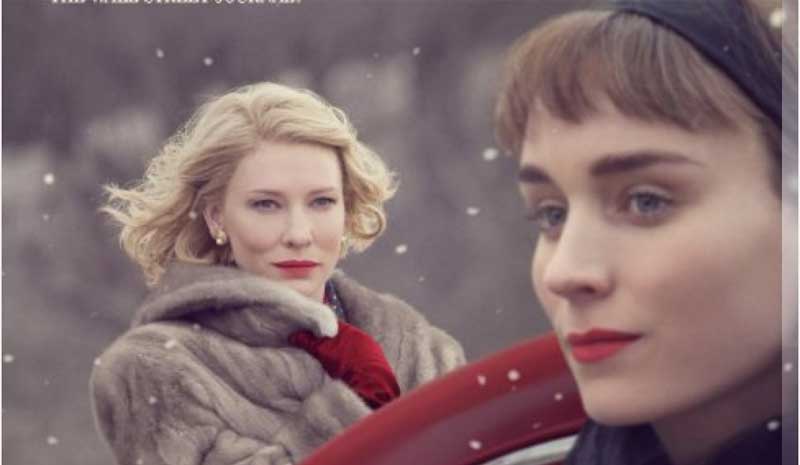Carol was a simple story about two people falling in love. It was much more as well. It was a story about Carol (Cate Blanchett) and Therese (Rooney Mara) and the hidden look in their eyes, the hidden meaning in their touch, the hidden hope in their togetherness.
Mild spoilers ahead.
Carol was a story about the particular artistic sensibility of director Todd Haynes – how he interpreted and painted the 1950s on the screen. It was a story about how Haynes used his camera to study the perfection of Cate Blanchett’s face to make her icy calm electrifying.
It was a story about how the screenplay by Phyllis Nagy could release all the words from Patricia Highsmith’s novel – turn them into silence, into action, into longing and lust and fear and courage. (Deadline has a great interview with Phyllis Nagy.)

Carol was a story about how a man, a husband like Harge (Kyle Chandler), or any man, could separate a mother and her child because she didn’t love him, but instead loved a woman.
It was a story about how a lifetime friend like Abby (Sarah Paulson) could be a summer lover and still a friend when summer was over. It was a story about how two women who know each others secrets support each other.
It was a story about Therese, a young woman who said yes to everything until she finally found the one resounding yes that would nourish her heart.
Carol shows the revolutionary act of political courage for two women to fall in love and hope to be together.The 1950s refrigerated souls. There was no opening the door to let in the light and warmth. There was only longing, eyes meeting, glimpses of happiness through rain splattered windows. True spirit was kept hidden, repressed.
Carol was a simple story about two people falling in love. That’s true. But it was also a revolutionary act of political courage for two women to fall in love and hope to be together.
The Crowd Reacts to Carol
After the film, I was struck speechless. I turned off the radio in my car on the way home because I couldn’t bear to have a single sound in my head. It took me several days to begin this post because I didn’t know if I possessed a complete sentence about Carol. Now that I’ve managed to put a few thoughts together about it, I’m going to let some of the many lesbians in the theater with me share their thoughts.
A couple of seats down from me in the same row of the theater, was a couple who provided sound effects during the movie. They cooed with delight when Carol and Therese touched, kissed, and finally made love. They chuckled with knowing appreciation when dykes in shops checked out Therese and when Carrie Brownstein’s character eyed Therese at a party. I didn’t hear anything from them during the horrifying scene in the lawyer’s office when Carol was faced with the possibility of losing her daughter. Or maybe I was too angry about the patriarchy to notice just then.
“It was what I was hoping.”When Carol was over, as that last unresolved chord of sound was left hanging in the air like a question over Carol and Therese’s avid eyes, I was shocked back into my body. I’d been inside the story completely. Now I struggled up out of my too-low seat, hoping my knees would work, and turned to my companion. “What did you think of the ending?” I asked.
“It didn’t really end, did it?” she said.
“Was it what you were expecting?”
She answered, “It was what I was hoping.”
As we were leaving, making side trips to the restroom and zipping up our coats, I was introduced to two women – a married couple. I said, “How did you like the movie.”
Both answered at once, “I loved it.”
They provided the final words on Carol.
I loved it.
Discover more from Old Ain't Dead
Subscribe to get the latest posts sent to your email.

Excellent!!!!